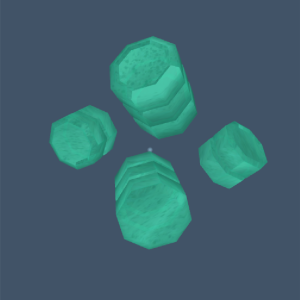Thylakoids
Thylakoids are organelles containing proteins and green pigments which use energy from Sunlight ![]() to produce Glucose
to produce Glucose ![]() from water and gaseous Carbon Dioxide
from water and gaseous Carbon Dioxide ![]() in a process called Chromatophore Photosynthesis. Since the rate of Glucose
in a process called Chromatophore Photosynthesis. Since the rate of Glucose ![]() production scales with intensity of Sunlight
production scales with intensity of Sunlight ![]() , Thylakoids are only effective in patches near the surface.
, Thylakoids are only effective in patches near the surface.
Prokaryotic form of the Chloroplast, which performs the full-strength version of Photosynthesis.
Requirements
If organelle upgrades are enabled in game settings, the following condition must be true for the player cell:
- Is in a patch with at least 20% Sunlight
 .
.
Processes
Chromatophore Photosynthesis: Sunlight ![]() + Carbon Dioxide
+ Carbon Dioxide ![]() → Glucose
→ Glucose ![]() + Oxygen
+ Oxygen ![]()
Now you can eat Sunlight ![]() . Taste the sun. Note Thylakoids can't perform Chromatophore Photosynthesis in dark patches, and the closer to the surface a cell travels, the more effective this process is.
. Taste the sun. Note Thylakoids can't perform Chromatophore Photosynthesis in dark patches, and the closer to the surface a cell travels, the more effective this process is.
Glycolysis: Glucose ![]() → ATP
→ ATP ![]()
Since Thylakoids are suspended directly in the Cytoplasm, the surrounding fluid performs Glycolysis.
Modifications
No modifications
Effects
No special effects.
Upgrades
No upgrades.
Strategy
In patches with high levels of Sunlight ![]() , a single hex with Thylakoids is a self-sustaining energy factory. Via Chromatophore Photosynthesis and then Glycolysis, they essentially generate free energy.
, a single hex with Thylakoids is a self-sustaining energy factory. Via Chromatophore Photosynthesis and then Glycolysis, they essentially generate free energy.
They are though only viable in surface-level patches such as the epipelagic or tidepools. It's vital to ensure you currently live in a valid patch before transitioning to this energy generation method. Once established, building an effective photosynthesizer is as simple as ensuring that there is net positive Glucose ![]() production in the cell and enough energy to sustain it. Further, much of a cell's energy consumption is from movement, so sitting still can drastically increase net Glucose
production in the cell and enough energy to sustain it. Further, much of a cell's energy consumption is from movement, so sitting still can drastically increase net Glucose ![]() production.
production.
If the day/night cycle is enabled in game settings, building an effective photosynthetic cell can be challenging. Place as many photosynthesizing parts as you can afford to ensure maximum Glucose ![]() production, as well as parts with decent storage (such as Vacuoles) to build up storage for the night ahead. We recommend sitting still at night to consume less energy, or otherwise pursue prey if you have a mixotrophic setup. We also recommend reproducing around morning when lux levels begin to rise, as after reproducing you will have halved your stores of Glucose
production, as well as parts with decent storage (such as Vacuoles) to build up storage for the night ahead. We recommend sitting still at night to consume less energy, or otherwise pursue prey if you have a mixotrophic setup. We also recommend reproducing around morning when lux levels begin to rise, as after reproducing you will have halved your stores of Glucose ![]() .
.
Scientific Background
Thylakoids are membrane-bound organelles found in real-world cyanobacteria and chloroplasts. They are typically disk-shaped and occur in "stacks" known as grana (singular granum).
Thylakoids contain at least 335 different types of protein, with around 42% of these being involved in photosynthesis. Three key protein complexes within thylakoids are photosystems I and II (absorbs light and uses the energy to catalyze chemical reactions as part of the thylakoid electron transport chain), the cytochrome b6f complex (catalyzes the transfer of electrons from plastoquinol to plastocyanin as part of the thylakoid electron transport chain), and ATP synthase (generates ATP using a proton gradient across a membrane).
